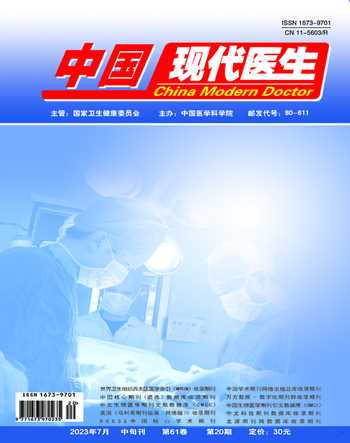剪切波弹性成像评价健康成年人跟腱硬度的研究
2023-08-08占小梅崔晓颖陈秀黄鑫鑫邹春鹏董雁雁
占小梅 崔晓颖 陈秀 黄鑫鑫 邹春鹏 董雁雁



[摘要] 目的 探討应用剪切波弹性成像评价健康成年人跟腱硬度的临床价值。方法 选取2021年12月至2022年6月在温州医科大学附属第二医院进行检查的90名健康志愿者,根据年龄分为青年组(18~44周岁,n=30)、中年组(45~59周岁,n=30)和老年组(60周岁以上,n=30),应用剪切波弹性成像(shear wave elastography,SWE)技术测量所有受试对象双侧跟腱近段、中段、远段的杨氏模量值,同时测量跟腱厚度。结果 老年组及中年组两侧跟腱均显著厚于青年组(P<0.05),老年组与中年组两侧跟腱厚度比较,差异无统计学意义(P>0.05)。老年组两侧跟腱近段杨氏模量值显著小于青年组(P<0.05);3组的两侧跟腱中段和远段杨氏模量值比较,差异均无统计学意义(P>0.05)。年龄与双侧侧跟腱厚度均呈显著正相关(P<0.05),双侧跟腱中段、远段杨氏模量值年龄均与无显著相关性(P>0.05),跟腱近段杨氏模量值与年龄呈显著负相关(P<0.05)。结论 健康成年人的跟腱厚度随着年龄增长而增加,跟腱近段的硬度随着年龄的增长而降低,并可以通过SWE进行评价。
[关键词] 剪切波弹性成像;跟腱;杨氏模量值;厚度
[中图分类号] R445.1 [文献标识码] A [DOI] 10.3969/j.issn.1673-9701.2023.20.007
Evaluation of Achilles tendon stiffness in healthy adults by shear wave elastography
ZHAN Xiaomei, CUI Xiaoying, CHEN Xiu, HUANG Xinxin, ZOU Chunpeng, DONG Yanyan
Department of Ultrasound, the Second Affiliated Hospital of Wenzhou Medical University, Wenzhou 325027, Zhejiang, China
[Abstract] Objective To investigate the clinical values of shear wave elastography in the evaluation of Achilles Tendon stiffness in healthy adults. Methods A total of 90 healthy volunteers who came to the Second Affiliated Hospital of Wenzhou Medical University for examination from December 2021 to June 2022 were collected and divided into youth group(18-44 years old, n=30), middle-aged group (45-59 years old, n=30) and elderly group (60+years old, n=30) according to age. Shear wave elastography (SWE) was used to measure Youngs modulus values in the proximal, middle and distal segments of the Achilles tendon bilaterally in all subjects, as well as measuring Achilles tendon thickness. Results The Achilles tendon was significantly thicker on both sides in the elderly and middle-aged groups than those in the young group (P<0.05), and there was no statistically significant difference between the thickness of the Achilles tendon on both sides in the elderly and middle-aged groups (P>0.05). The Youngs modulus values of the proximal segment of the Achilles tendon were significantly smaller in the elderly group than those in the young group (P<0.05); the differences in Youngs modulus values of the middle and distal segments of the Achilles tendon between the three groups were not statistically significant (P>0.05). There was a significant positive correlation between age and lateral Achilles tendon thickness on both sides (P<0.05), no significant correlation between Youngs modulus values in the middle and distal segments of the Achilles tendon on both sides (P>0.05), and a significant negative correlation between Young's modulus values in the proximal segment of the Achilles tendon and age (P<0.05). Conclusion The thickness of the Achilles tendon in healthy adults increases with age, and the stiffness of the proximal achilles tendon decreases with age, which can be evaluated by SWE.
[Key words] Shear wave elastography; Achilles Tendon; Youngs modulus; Thickness
![]() 跟腱是位于小腿后方的一條很粗壮的肌腱,是人体最强壮、最大、最厚的肌腱[1],也是所有肌腱中随着年龄老化发生断裂概率最大的肌腱,其主要原因被认为与肌腱硬度的改变相关[2]。随着超声新技术的发展,除了常规二维超声用于跟腱的检查,剪切波弹性成像(shear wave elastography,SWE)技术也逐步应用于跟腱疾病的诊断。有研究表明,SWE可做为一种非侵入性检测跟腱力学特性的的可靠工具[3],已有研究证实超声弹性成像与常规二维成像在组织学上有良好的一致性[4]。但是目前有关跟腱硬度变化与年龄变化之间关系的研究较少,因此本研究对SWE对于健康成年人跟腱硬度评价进行了探讨。
跟腱是位于小腿后方的一條很粗壮的肌腱,是人体最强壮、最大、最厚的肌腱[1],也是所有肌腱中随着年龄老化发生断裂概率最大的肌腱,其主要原因被认为与肌腱硬度的改变相关[2]。随着超声新技术的发展,除了常规二维超声用于跟腱的检查,剪切波弹性成像(shear wave elastography,SWE)技术也逐步应用于跟腱疾病的诊断。有研究表明,SWE可做为一种非侵入性检测跟腱力学特性的的可靠工具[3],已有研究证实超声弹性成像与常规二维成像在组织学上有良好的一致性[4]。但是目前有关跟腱硬度变化与年龄变化之间关系的研究较少,因此本研究对SWE对于健康成年人跟腱硬度评价进行了探讨。
1 资料与方法
1.1 一般资料
选取2021年12月至2022年6月在温州医科大学附属第二医院进行检查的90名健康志愿者,根据年龄分为青年组(18~44周岁,n=30)、中年组(45~59周岁,n=30)和老年组(60周岁以上,n=30)。纳入标准:①平时偶尔运动;②无跟腱疼痛病史、外伤史及手术史;③无系统性炎性病变(如风湿性关节炎、脊椎关节病变等)、无血胆固醇增高等;排除标准:①严重神经病变、足部溃疡、严重动脉病变者;②职业运动员或长期从事重体力劳动者等。每组男24例,女6例。青年组平均年龄(35.20±7.12)岁,体质量指数(24.25±4.39)kg/m2;中年组平均年龄(53.70±3.98)岁,体质量指数(24.53±2.72)kg/m2;老年组平均年龄(68.63±5.11)岁,体质量指数(24.00±3.54)kg/m2。各组体质量指数、性别比例比较,差异无统计学意义(P>0.05),具有可比性。所有被检者均已知情同意,本研究经温州医科大学附属第二医院伦理委员会审批通过(伦理审批号:伦审2022-K-162-02)。
1.2 方法
彩色多普勒超声诊断仪为Mindray Resona 7T,探头型号L11-3U,频率4~13MHz。受检者取俯卧位,充分暴露双侧踝关节并悬于检查床外,下肢放松,踝关节处于自然位。首先将跟腱划分为3段,分别为近段(肌–腱结合部)、中段(跟腱跟骨附着端以上2~6cm处)及远段(跟腱跟骨附着端)。首先检查受检者左侧跟腱,在常规二维横切面测量跟腱最大厚度,纵切面观察整条跟腱的内部纤维结构回声。然后沿跟腱纵向将探头垂直于跟腱进行超声弹性成像检查,按由远及近的顺序分别检测跟腱远段、中段、近段的硬度情况:在STE模式下,待图像稳定(图像上星级评估系统达4星及以上),冻结图像并进行杨氏模量值测量,每段跟腱重复测量6次取平均值。使用同样方法对右侧跟腱进行检测。值得注意的是,在扫查过程中,需要使用足够量的超声凝胶来保持超声探头和皮肤之间的良好接触,同时避免对跟腱加压,并且注意观察跟腱内部回声,如在弹性检测区域存在钙化,则予以剔除。
1.3 统计学方法
采用SPSS 26.0统计学软件对数据进行处理分析,计量资料以均数±标准差(![]() )表示,组间比较采用单因素ANOVA分析,年龄与跟腱厚度、杨氏模量值的相关性分析采用Pearson法。P<0.05为差异有统计学意义。
)表示,组间比较采用单因素ANOVA分析,年龄与跟腱厚度、杨氏模量值的相关性分析采用Pearson法。P<0.05为差异有统计学意义。
2 结果
2.1 跟腱厚度、跟腱各段杨氏模量值比较
老年组及中年组两侧跟腱均显著厚于青年组(P<0.05),老年组与中年组两侧跟腱厚度比较,差异无统计学意义(P>0.05)。老年组两侧跟腱近段杨氏模量值显著小于青年组(P<0.05);3组的两侧跟腱中段和远段杨氏模量值比较,差异均无统计学意义(P>0.05),见表1、图1。
2.2 年龄与双侧跟腱厚度的相关性分析
年龄与左、右侧跟腱厚度均呈显著正相关(P=0.001,r=0.333;P=0.002,r=0.326),随着年龄的增加,跟腱厚度逐渐变厚,见图2。
2.3 年龄与左侧三段跟腱杨氏模量值的相关性分析
左侧跟腱中段、远段杨氏模量值均与年龄无显著相关(P=0.405,r= –0.089;P=0.843,r=0.021);跟腱近段杨氏模量值与年龄呈显著负相关(P=0.016,r= –0.253)。随着年龄的增长,跟腱近段杨氏模量值有逐渐减小的趋势,见图3。
2.4 年龄与右侧三段跟腱杨氏模量值的相关性分析
右侧跟腱中段、远段杨氏模量值与年龄均无显著相关(P=0.156,r= –0.151;P=0.881,r= –0.016);跟腱近段杨氏模量值与年龄呈显著负相关(P=0.021,r= –0.242)。随着年龄的增长,近段杨氏模量值有逐渐减小的趋势,见图4。
3 讨论
随着人口老龄化速度的加快,近年來老年人跟腱断裂发病率逐步升高[5],流行病学研究表明老年人跟腱再断裂的风险性在50岁之后可达峰值[6]。有研究认为,老年人往往不是因为外伤或剧烈体育运动,
A.青年组跟腱远段成像;B青年组跟腱中段成像;C.青年组跟腱近段成像;D.中年组跟腱远段成像;E.中年组跟腱中段成像;F.中年组跟腱近段成像;G.老年组跟腱远段成像;H.老年组跟腱中段成像;I.老年组跟腱近段成像更多的是隐匿性关节损伤或慢性跟腱病所致[5]。随着年龄的增长,老年人的肌肉力量下降、数量减少,肌腱性能发生改变[7-8]。肌腱是肌肉传递力量至骨骼的载体,对于整个关节复合体的功能起着至关重要的作用,肌腱功能的维持依靠组织弹性。对于肌腱组织弹性的测量,SWE是首选的非侵入性的检测方法,除评估肌肉和肌腱僵硬度之外,还可识别损伤,如断裂或肌腱病[9-10]。
本研究结果显示,老年组、中年组两侧跟腱较青年组厚度显著增加,跟腱厚度随着年龄的增长而增厚,相关性分析也表明跟腱厚度与年龄呈正相关,此结论与以往相关研究结果相似[11-12]。其机制可能是,身体各部位随着年龄增长而发生代谢的变化,如脂质代谢水平随年龄的改变,血浆中三酰甘油浓度随着年龄的增长而增加[13-14],老年男性表现更加明显。男性衰老之后,雄激素的分泌减少,对脂质代谢的负面影响减弱,增加全身脂肪的堆积,跟腱内部及周围脂肪堆积增加,腱细胞体积增大,跟腱日益增厚。老年组两侧跟腱近段杨氏模量值明显小于青年人组,3组跟腱中段、远段的杨氏模量值比较,差异均无统计学意义。相关性分析结果也表明近段跟腱硬度与年龄呈负相关,而中段、远段跟腱硬度与年龄无明显相关性。这可能是因为近段跟腱的解剖位置特殊,其与大多数肌腱不同,其可分为3个不同的亚肌腱[15-16],由腓肠肌内侧、腓肠肌外侧和比目鱼肌在远端融合成一个肌腱,并不是一个统一的共同肌腱[17-18]。人体跟腱解剖学实验已证实单个小腿三头肌的单独负荷可导致跟腱的不均匀负荷,造成跟腱不均匀变形,并且相比于中段及远段跟腱,近段跟腱显示出明显的肌纤维特征,更易变形[19-20]。另外,近段跟腱是肌肉与中段和远段跟腱的结合部位,该处有较多血管进入肌腱,明显多于中段和远段跟腱。随着年龄的增长,血管内皮细胞受损和血管数量减少[21],此现象在近段跟腱的情况明显重于中远段跟腱。
综上所述,通过SWE检测跟腱的杨氏模量值,可为临床提供跟腱硬度的定量指标,是传统超声的有益补充,对临床在相关疾病预防保健及诊治方面提供重要的参考依据。本研究存在一定的局限性,入组例数较少且为单中心研究,在未来的研究中需继续扩大样本量,尽量减少各种偏倚的发生。
[参考文献]
[1] DORAL M N, ALAM M, BOZKURT M, et al. Functional anatomy of the Achilles tendon[J]. Knee Surg Sports Traumatol Arthrosc, 2010, 18(5): 638–643.
[2] LACROIX A S, DUENWALD-KUEHL S E, LAKES R S, et al. Relationship between tendon stiffness and failure: a metaanalysis[J]. J Appl Physiol (1985), 2013, 115(1): 43–51.
[3] HAEN T X, ROUX A, SOUBEYRAND M, et al. Shear waves elastography for assessment of human Achilles tendons biomechanical properties: an experimental study[J]. J Mech Behav Biomed Mater, 2017, 69: 178–184.
[4] KLAUSER A S, MIYAMOTO H, TAMEGGER M, et al. Achilles tendon assessed with sonoelastography: histologic agreement[J]. Radiology, 2013, 267(3): 837–842.
[5] 朱尧卿, 徐向阳, 朱渊. 长屈肌腱转位手术治疗老年跟腱断裂的疗效分析[J]. 中国骨与关节外科, 2014, 7(4): 292–295.
[6] MAEMPEL J F, WHITE T O, MACKENZIE S P, et al. The epidemiology of Achilles tendon re-rupture and associated risk factors: male gender, younger age and traditional immobilising rehabilitation are risk factors[J]. Knee Surg Sports Traumatol Arthrosc, 2022, 30(7): 2457–2469.
[7] NARICI M V, MAFFULLI N, MAGANARIS C N. Ageing of human muscles and tendons[J]. Disabil Rehabil, 2008, 30(20-22): 1548–1554.
[8] MAGNUSSON S P, KJAER M. The impact of loading, unloading, ageing and injury on the human tendon[J]. J Physiol, 2019, 597(5): 1283–1298.
[9] FRANKEWYCZ B, HENSSLER L, WEBER J, et al. Changes of material elastic properties during healing of ruptured achilles tendons measured with shear wave elastography: a pilot study[J]. Int J Mol Sci, 2020, 21(10): 3427.
[10] DIRRICHS T, QUACK V, GATZ M, et al. Shear wave elastography (SWE) for the evaluation of patients with tendinopathies[J]. Acad Radiol, 2016, 23(10): 1204–1213.
[11] FU S, CUI L, HE X, et al. Elastic characteristics of the normal achilles tendon assessed by virtual touch imaging quantification shear wave elastography[J]. J Ultrasound Med, 2016, 35(9): 1881–1887.
[12] NAKAGAWA Y, HAYASHI K, YAMAMOTO N, et al. Age-related changes in biomechanical properties of the Achilles tendon in rabbits[J]. Eur J Appl Physiol Occup Physiol, 1996, 73(1-2): 7–10.
[13] KOLOVOU G, KATSIKI N, PAVLIDIS A, et al. Ageing mechanisms and associated lipid changes[J]. Curr Vasc Pharmacol, 2014, 12(5): 682–689.
[14] LUEVANO-CONTRERAS C, CHAPMAN-NOVAKOFSKI K. Dietary advanced glycation end products and aging[J]. Nutrients, 2010, 2(12): 1247–1265.
[15] HANDSFIELD G G, SLANE L C, SCREEN H R C. Nomenclature of the tendon hierarchy: an overview of inconsistent terminology and a proposed size-based naming scheme with terminology for multi-muscle tendons[J]. J Biomech, 2016, 49(13): 3122–3124.
[16] HANDSFIELD G G, GREINER J, MADL J, et al. Achilles subtendon structure and behavior as evidenced from tendon imaging and computational modeling[J]. Front Sports Act Living, 2020, 2: 70.
[17] EDAMA M, KUBO M, ONISHI H, et al. The twisted structure of the human Achilles tendon[J]. Scand J Med Sci Sports, 2015, 25(5): e497–e503.
[18] SZARO P, WITKOWSKI G, SMIGIELSKI R, et al. Fascicles of the adult human Achilles tendon—an anatomical study[J]. Ann Anat, 2009, 191(6): 586–593.
[19] ARNDT A, BRüGGEMANN G P, KOEBKE J, et al. Asymmetrical loading of the human triceps surae: I. Mediolateral force differences in the Achilles tendon[J]. Foot Ankle Int, 1999, 20(7): 444–449.
[20] GOLLNICK P D, SJ?DIN B, KARLSSON J, et al. Human soleus muscle: a comparison of fiber composition and enzyme activities with other leg muscles[J]. Pflugers Arch, 1974, 348(3): 247–255.
[21] UNGVARI Z, TARANTINI S, KISS T, et al. Endothelial dysfunction and angiogenesis impairment in the ageing vasculature[J]. Nat Rev Cardiol, 2018, 15(9): 555–565.
(收稿日期:2022–10–17)
(修回日期:2022–11–16)
